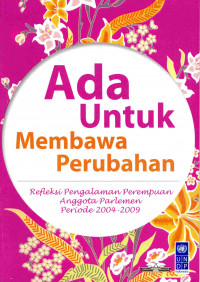
Text
Ada Untuk membawa Perubahan : Refleksi Pengalaman Perempuan Anggota Parlemen Periode 2004-2009
HIRUK pikuk pesta demokrasi lima tahunan, utamanya dalam menyambut pemilu legislatif 9 April lalu, setidaknya disesaki oleh maraknya wacana keterwakilan politik perempuan dalam panggung politik elektoral Indonesia. Praktis, selama lebih dari tiga dasawarsa, publik politik nasional terus menyimak gugatan intens kaum perempuan terhadap kontruksi budaya dan relasi sosial-politik pasca reformasi yang masih bias jender, dan terindikasi menyimpan potensi untuk tetap memarjinalisasi dan mendominasi perempuan. Gugatan kaum perempuan ini sejalan dengan kian menguatnya isu keadilan dan kesetaraan jender yang makin mendapat tempat dalam wacana politik masyarakat dan ruang-ruang kebijakan negara. Meski negara kini relatif akomodatif terhadap wacana dan tuntutan keterwakilan politik perempuan (seperti tercermin dalam Undang-Undang Nomor 2 Tahun 2008 tentang Partai Politik dan Undang-Undang Nomor 10 Tahun 2008 tentang Pemilihan Umum), namun harus disadari bahwa ruang ekspresi politik perempuan yang diberikan negara (dan para elite partai) masih jauh dari spirit keadilan dan keseteraan. Kendati penetapan kuota 30 persen melalui akomodasi negara sudah di uji-coba sejak pemilu 2004 lalu, namun ditilik dari aspek sejarah pertumbuhan representasi politik perempuan di parlemen, faktual masih berlangsung secara fluktuatif. Catatan representasi politik perempuan menunjukkan angka naik turun dari waktu ke waktu terkait keterlibatan perempuan dalam arena politik praktis, khususnya di lembaga legislatif. Anggota DPR Sementara 1950–1955 misalnya, berhasil mengakomodasi 9 Representasi Politik Perempuan: Sekadar Warna, Atau Turut Mewarnai? Edisi 6 Tahun 2 Juni - Agustus 2009 Pengantar Redaksi Just a Colour or Gives Colour? Women Political Representation: The five years feast of democracy, especially the last legislative general election on 9 April, at least is crowded with the discourse of woman political representation on Indonesian electoral political stage. At least during more than three decades, national political public keeps witnessing women intense criticism on the still gender biased- construction and social political relations after reform era and the strong indication of marginalization potential, even suppression on the women political rights. This women criticism is in line with the more strengthened issue of justice and gender equality that gets acknowledged more in the political discourse within society and public policies. Even the state now is relatively accommodative to the discourse and claims of women political representation (as stated in the Law No. 2 Year 2008 on Political Party and Law No. 10 Year 2008 on General Election), yet the space for women political expression given by the state (and party elites) is still too far away from spirits of justice and equality. Even though the 30 percent quota establishment through state accommodation has been an experiment since 2004 general election, women political representation in the parliament from historical aspect is in fact still fluctuatively ongoing. Data on women political representation shows that the number goes up and down from time to time in accordance to the women engagements in practical political arena, especially within the legislative institution. Temporary Legislative Members (DPRS) 1950-1955 for instance, were successful in accommodating 9 seats for women (3.8%) from 236 legislative members at that time. The result of general election 1955-1960 showed increasing number to 17 seats (6.3%) from 272 elected parliament members. Women representation in the parliament also quantitatively went up and down during the Constituent Assembly era (1956-1959) to 25 seats (5.1%) from 488 seats of Constituent Assembly members. During New Order era, women political representation in parliament also experienced up and down. The first New Order general election (1971-1977) succeeded to give 36 seats to women (7.8%), general election 1977 resulted 29 seats (6.3%), and 39 seats (8.5%) from 460 elected parliament members during those three election periods. Furthermore, general election 1987 gave 65 seats for women (13%) from 500 parliament seats, and from there kept decreasing during election 1992-1997, 1997-1999, and 1999-2004 by 62 seats (12.5%), 54 seats (10.8%), and 46 seats for women (9%) from each 500 seats achieved by respective parliament members at each period. The general election 2004 was successful to increase the number of
Availability
| KP.II 000226 | KP.II VEN a | My Library | Available |
| KP II.000226-01 | KP.II VEN a | My Library | Available |
Detail Information
- Series Title
-
-
- Call Number
-
KP.II VEN a
- Publisher
- Jakarta Indonesia : UNDP Indonesia., 2010
- Collation
-
x, 108p. : ill. ; 21cm.
- Language
-
Indonesia
- ISBN/ISSN
-
978-602-97036-0-3
- Classification
-
KP.II
- Content Type
-
-
- Media Type
-
-
- Carrier Type
-
-
- Edition
-
April 2010
- Subject(s)
- Specific Detail Info
-
-
- Statement of Responsibility
-
-
Other version/related
No other version available
File Attachment
Comments
You must be logged in to post a comment
 Computer Science, Information & General Works
Computer Science, Information & General Works  Philosophy & Psychology
Philosophy & Psychology  Religion
Religion  Social Sciences
Social Sciences  Language
Language  Pure Science
Pure Science  Applied Sciences
Applied Sciences  Art & Recreation
Art & Recreation  Literature
Literature  History & Geography
History & Geography